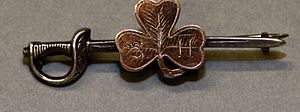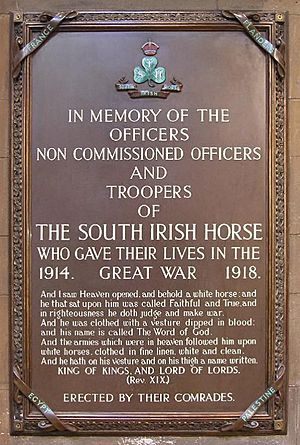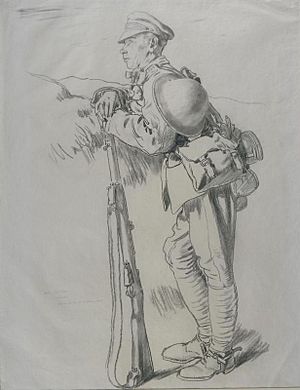South Irish Horse facts for kids
Quick facts for kids South Irish Horse |
|
|---|---|

A "Sweetheart pin" with the emblem of the South Irish Horse (SIH), sent by a soldier to his girlfriend as a memento
|
|
| Active | 7 January 1902–31 July 1922 |
| Country | |
| Branch | |
| Type | Yeomanry |
| Size | 4–6 Squadrons |
| RHQ | Limerick Dublin |
| Commanders | |
| Colonel-in-Chief | Field Marshal Arthur, Duke of Connaught and Strathearn |
The South Irish Horse was a special group of soldiers in the British Army. They rode horses and were part of the cavalry. They started in 1902 as the South of Ireland Imperial Yeomanry. This group continued the work of a unit from the Second Boer War. In 1908, they became part of the Special Reserve and changed their name to the South Irish Horse. They fought in World War I. After Ireland became independent in 1922, the group was disbanded.
Contents
The Imperial Yeomanry: Mounted Soldiers
During the Second Boer War (1899-1902), the British government needed more soldiers. They especially needed mounted units, which were soldiers who rode horses. So, in 1899, they decided to let volunteer forces join the fight.
On December 24, 1899, the Imperial Yeomanry (IY) was officially created. These were companies of about 115 men who signed up for one year. They were trained to fight on horseback, like mounted infantry. They used rifles and bayonets instead of cavalry swords.
Forming the South Irish Horse
One of the units created was the 61st (South Irish Horse (Dublin)) Company. It started on March 7, 1900, in Dublin. This company was part of the 17th Battalion, IY. They served alongside the 60th (North Irish Horse (Belfast)) Company.
The 17th Battalion traveled by ship to Portuguese East Africa in April 1900. They joined the Rhodesian Field Force. The soldiers faced sickness and some deaths during their journey. They eventually moved into Transvaal and later to Kimberley.
The war turned into a long period of Guerrilla warfare, with British mounted troops chasing Boer forces. Many Imperial Yeomanry soldiers went home after their year of service. New recruits replaced them.
The Imperial Yeomanry was seen as a success. In 1901, many part-time cavalry groups became Imperial Yeomanry. Also, 18 new regiments were formed, including two in Ireland. The 61st (South Irish Horse) Company continued as the South of Ireland Imperial Yeomanry. This was approved by King Edward VII in 1901 and officially started on January 7, 1902. The regiment was first based in Limerick.
The Marquess of Waterford became the commanding officer in February 1902. He was a former officer in the Royal Horse Guards. He later went to South Africa with another unit, but returned home when the war ended. He then took command of the new South Irish regiment.
Special Reserve: A New Role
In 1907, new military changes called the Haldane Reforms happened. Most Imperial Yeomanry groups became part of the new Territorial Force. However, this did not include Ireland.
Instead, the South Irish Horse became part of the Special Reserve (SR). This was a reserve force for the regular army. The South Irish Horse officially joined the SR on October 20, 1908.
Where They Were Based
The regiment had its headquarters and squadrons in different places:
- HQ - Artillery Barracks, Limerick (moved to Dublin by 1914)
- A Squadron - Beggars Bush Barracks, Dublin
- B Squadron - Artillery Barracks, Limerick
- C Squadron - Glen House, Ballyvolane, Cork
- D Squadron - Beggars Bush Barracks, Dublin
The Marquess of Waterford passed away in 1911. From 1912, Lord Decies became the commanding officer. Before World War I, the South Irish Horse was linked to the regular 3rd Cavalry Brigade at The Curragh.
World War I: Fighting for Freedom
When war was declared against Germany in August 1914, the South Irish Horse was at summer camp. One squadron from the South Irish Horse (called B Squadron) and one from the North Irish Horse (called A Squadron) were sent to France. They sailed from Dublin on August 17, 1914.
During the First Battle of Ypres in October 1914, two small groups from B Squadron helped fill a gap in the battle line at Hollebeke. This was a very important moment in the fighting.
Cavalry Squadrons in Action
Other squadrons, including three new ones formed during the war, joined different army divisions. A Reserve Regiment was set up in Cahir in 1914 to send new soldiers to the fighting squadrons.
- A Squadron – Joined the 21st Division in 1915. They landed in France on September 12, 1915. Later, they became part of different Corps Cavalry Regiments.
- B Squadron – Went to France in August 1914. They joined the 2nd Division in May 1915. Later, they became part of I Corps Cavalry Regiment.
- C Squadron – Joined the 16th (Irish) Division in 1915 and went to France in December 1915. They also became part of I Corps Cavalry Regiment.
- E Squadron – Landed in France in March 1916 and joined the 39th Division. They later joined I Corps Cavalry Regiment.
- S Squadron – Joined the 32nd Division in 1915 and landed in France in November 1915. They later became part of XV Corps Cavalry Regiment.
By May 1916, C, E, and S Squadrons formed the 1st South Irish Horse. A, B, and F Squadrons formed the 2nd South Irish Horse.
Becoming Infantry Soldiers
The fighting on the Western Front involved a lot of Trench warfare. This meant there wasn't much need for soldiers on horseback. So, in August 1917, the 1st and 2nd South Irish Horse units combined. They stopped being cavalry and were retrained as infantry soldiers.
They became the 7th (South Irish Horse) Battalion of the Royal Irish Regiment. This happened between September and November 1917. They then joined the 49th Brigade of the 16th (Irish) Division.
During the German Spring Offensive in March 1918, the 16th (Irish) Division faced a strong German attack. Many soldiers from the 7th Battalion Royal Irish Regiment were caught by surprise and suffered heavy losses. The survivors retreated to the River Somme.
After these losses, the battalion was rebuilt in June 1918. New soldiers joined from other Irish regiments. The rebuilt 7th (SIH) Battalion joined the 21st Bde in the 30th Division in July. They served with this division until the end of the war. They took part in battles like the Capture of Wulverghem and the Battle of Courtrai.
Disbandment
The South Irish Horse was one of six southern Irish regiments of the British Army. It was disbanded on July 31, 1922. This happened after the new Irish Free State was created.
Heritage and Traditions

Uniform and Badges
The Imperial Yeomanry wore khaki service uniforms. The South Irish Horse had a special parade uniform until 1914. It included a green tunic with red and green colors. Their trousers were green with double red stripes. They wore a dark green cap with a red band. A gold shamrock badge was used on their cap and collar.
Honorary Colonel
The Honorary Colonel of the regiment was Field Marshal Prince Arthur, Duke of Connaught and Strathearn. He was appointed on March 19, 1904.
Battle Honours
The regiment was given special awards called Battle honours for their bravery in battles:
|
Great War Memorials
The South Irish Horse is remembered at several memorials:
- Irish National War Memorial Gardens, Dublin.
- Island of Ireland Peace Park Messines, Belgium.
- Menin Gate Memorial Ypres, Belgium.
- Ulster Tower Memorial Thiepval, France.



